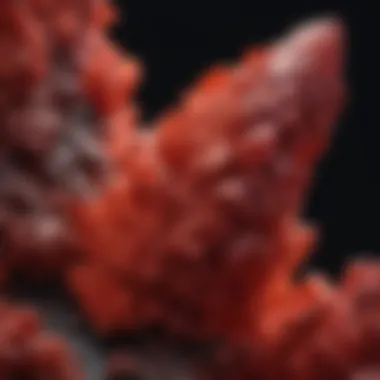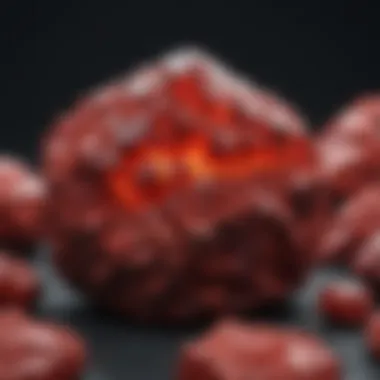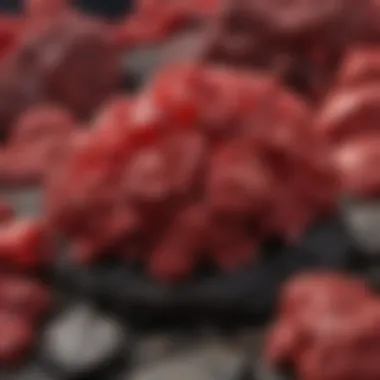Exploring the Enigmatic Charm of Cinnabar Mineral for Sale


Rock and Fossil Identification
When delving into the world of cinnabar mineral, it is vital to have a keen understanding of rock and fossil identification. Cinnabar, known for its vibrant red color and mercury content, falls under the category of sulfide minerals. Recognizing its distinctive characteristics can help enthusiasts discern cinnabar from other minerals. The deep red hue, often occurring in crystalline form, is a hallmark feature to look for when identifying this mineral. Utilizing tools such as a UV light can aid in distinguishing cinnabar due to the unique fluorescence it exhibits. Understanding these identification techniques is essential for collectors seeking to acquire this prized geological specimen.
Geological Insights
Exploring the geological insights associated with cinnabar mineral provides valuable context for collectors. Formed primarily in hydrothermal veins, cinnabar is commonly found near volcanic activity and hot springs. Its historical significance dates back centuries, with ancient civilizations recognizing its distinctive properties. The mineral's association with mercury has contributed to its widespread usage in various applications throughout history. Notable discoveries of cinnabar deposits have been instrumental in advancing scientific knowledge of mercury deposits and geological processes. By uncovering these geological formations and processes, collectors gain a deeper appreciation for the rich history and significance of cinnabar mineral.
Collecting Tips and Techniques
For collectors eager to acquire cinnabar mineral, understanding the best practices for collecting is paramount. Locating prime collecting sites where cinnabar is known to occur can increase the chances of finding high-quality specimens. Areas with volcanic activity or regions near geological fault lines are promising locations for cinnabar exploration. Safely extracting specimens is crucial to preserve both the mineral and surrounding environment. Tools such as rock hammers and chisels are essential for carefully extracting cinnabar without causing damage. These techniques not only ensure successful specimen collection but also promote responsible and sustainable collecting practices.
Preservation and Display
After acquiring cinnabar mineral, it is essential to employ proper preservation and display techniques to showcase its beauty. Preserving rocks and fossils involves techniques such as cleaning with a soft brush and storing in a low-humidity environment to prevent deterioration. Utilizing display cases or stands can highlight cinnabar specimens while protecting them from external elements. Creatively displaying cinnabar, whether individually or as part of a curated collection, adds aesthetic value and showcases its distinctive features. By implementing effective preservation and display methods, collectors can enjoy and share the allure of cinnabar mineral with others.
Introduction
Unveiling the captivating world of cinnabar mineral for sale is a journey into the realm of exceptional geological beauty and historical significance. This article serves as a guide to understanding the allure and desirability of cinnabar specimens, shedding light on key considerations for collectors and enthusiasts. By delving into the availability and nuances of cinnabar in the market, this comprehensive piece aims to provide valuable insights for those intrigued by the alluring appeal of this prized mineral.
Understanding Cinnabar Mineral
Formation and Composition
Exploring the intricate formation and composition of cinnabar brings to light the unique blend of elements that contribute to its striking characteristics. The amalgamation of mercury and sulfur under specific geological conditions gives rise to the vibrant red hue and distinctive sheen that define cinnabar specimens. This composition not only makes cinnabar a visually appealing choice but also adds to its value as a sought-after mineral in various collections.
Physical Characteristics
Delving into the physical characteristics of cinnabar unveils a spectrum of features that set this mineral apart. From its vibrant red hue that catches attention instantly to the smooth sheen that reflects light in an enchanting manner, cinnabar's physical attributes make it a standout choice for discerning collectors. The crystalline structure adds a layer of depth to its allure, showcasing the intricate patterns and textures that make each specimen a unique masterpiece.
Significance in Geology
The significance of cinnabar in geology goes beyond its visual appeal, delving into its formation processes and geological implications. Studying cinnabar offers valuable insights into the Earth's history, highlighting the environmental conditions that led to the creation of this distinctive mineral. Its presence in specific geological contexts provides clues about past environments and natural processes, making it a fascinating subject for geological enthusiasts and researchers alike.
Brief History of Cinnabar
Ancient Uses


Unraveling the ancient uses of cinnabar reveals a rich tapestry of cultural practices and societal beliefs intertwined with this mineral. From its utilization in traditional medicines to its role in artistic endeavors, cinnabar has held a significant place in various civilizations throughout history. The ancients recognized its transformative properties and revered it for its mystical associations, cementing its status as a prized commodity in ancient times.
Symbolism and Cultural Significance
Exploring the symbolism and cultural significance of cinnabar offers a glimpse into the deep-rooted beliefs and traditions that have shaped its perception over the centuries. Symbolizing vitality, luck, and divine connection in many cultures, cinnabar carries a weight of symbolism that transcends mere mineralogical value. Its cultural significance resonates through art, folklore, and rituals, reflecting the profound impact it has had on human societies across different epochs.
Notable Discoveries
Highlighting the notable discoveries associated with cinnabar unearths tales of exploration, scientific inquiry, and archaeological finds that have shed light on its diverse uses and cultural relevance. The discoveries of cinnabar deposits in various regions around the world have sparked curiosity and admiration for this mineral, prompting further investigations into its properties and applications. These noteworthy findings continue to fuel the fascination surrounding cinnabar, making it a subject of ongoing scientific interest and historical exploration.
Properties of Cinnabar
Color and Luster
Vibrant Red Hue
The vibrant red hue of cinnabar is one of its most striking features. This rich hue is not only visually captivating but also holds significant value in the world of minerals. The intense red coloring is a result of the presence of mercury sulfide in its composition. Collectors are drawn to the vibrant red hue of cinnabar specimens as it sets them apart from other minerals in collections. The bold and energetic nature of the red hue adds a touch of sophistication to any display, making it a sought-after choice for collectors looking to enhance the visual appeal of their collections.
Distinctive Sheen
Another key aspect of cinnabar's allure is its distinctive sheen. The mineral exhibits a lustrous quality that adds depth and character to its appearance. This sheen is often described as a silky or glassy finish, giving cinnabar a unique charm. The interplay of light on the surface of the mineral creates a captivating visual effect, enhancing its overall beauty. While the sheen adds a layer of elegance to cinnabar specimens, collectors should take precautions to preserve this delicate quality to maintain the mineral's allure over time.
Chemical Composition
Mercury Sulfide
The presence of mercury sulfide in cinnabar's chemical composition is a defining factor in its uniqueness. This compound not only contributes to the mineral's vibrant red color but also plays a role in its distinct properties. Mercury sulfide gives cinnabar its bold hue, making it instantly recognizable among collectors. Despite its beauty, the high mercury content in cinnabar emphasizes the importance of handling and storing the mineral with care to ensure both preservation and safety.
Crystalline Structure
Cinnabar's crystalline structure adds to its allure, showcasing intricate patterns and formations that mesmerize collectors. The crystalline structure of cinnabar gives each specimen a one-of-a-kind appeal, with variations in crystal shapes and sizes. Collectors appreciate the detailed arrangements within the crystal lattice, showcasing the mineral's geological complexity. However, the delicate nature of the crystalline structure requires careful maintenance to prevent damage and retain the aesthetic integrity of the specimens.
Acquiring Cinnabar Mineral
Exploring the process of acquiring cinnabar mineral is pivotal in understanding its allure and significance within the realm of geological specimens. For avid rock and fossil collectors, the acquisition of cinnabar presents a unique opportunity to delve into a mineral with rich historical importance and stunning physical properties. By delving into the sourcing methods, factors to consider, and market availability of cinnabar, collectors can expand their collections with a prized addition that offers both aesthetic and educational value.
Sources of Cinnabar


Natural Deposits
Cinnabar derived from natural deposits holds a special allure due to its intrinsic connection to the Earth's geology. These deposits are characterized by their unique geological formations, with cinnabar often occurring in association with other minerals, such as quartz or dolomite. The distinctive red hue of cinnabar found in natural deposits is highly prized by collectors for its vibrancy and authenticity. While mining these deposits can be labor-intensive, the beauty and purity of cinnabar sourced from natural reserves make it a popular choice among collectors seeking premium specimens.
Mining Locations
Mining locations play a crucial role in the extraction of cinnabar for collectors worldwide. These sites are carefully selected based on geological surveys and historical mining data to ensure the quality and quantity of cinnabar obtained. Mining locations offer access to diversified specimens due to variations in mineral composition and deposit formations. Despite the challenges associated with mining operations, these locations provide collectors with a wide range of cinnabar specimens, each boasting distinct characteristics that contribute to the diversity and allure of cinnabar collections.
Factors to Consider
Authenticity
Authenticity is a paramount consideration when acquiring cinnabar mineral for sale. Genuine cinnabar specimens exhibit specific physical and chemical properties that distinguish them from imitations or substitutes. Collectors value authentic cinnabar for its purity and historical significance, making authenticity a key factor in the decision-making process when adding to their mineral collections.
Quality
The quality of cinnabar specimens directly impacts their value and desirability among collectors. High-quality cinnabar displays vibrant coloration, distinct luster, and minimal impurities, reflecting the mineral's inherent beauty and geological significance. Collectors prioritize specimens of superior quality to enhance the overall aesthetic appeal and investment potential of their collections.
Ethical Sourcing
Ethical sourcing practices are gaining prominence in the mineral collection community, emphasizing sustainability and social responsibility in sourcing cinnabar specimens. By choosing ethically sourced cinnabar, collectors contribute to environmental conservation and support fair labor practices within the mining industry. Ethical considerations add a layer of conscientiousness to the acquisition process, ensuring that cinnabar specimens are obtained responsibly and with respect for communities and ecosystems.
Availability in the Market
Physical and Online Retailers
Physical and online retailers serve as primary outlets for cinnabar mineral sales, offering collectors a convenient platform to explore and purchase diverse specimens. These retailers curate selections of cinnabar sourced from various regions, allowing collectors to access a wide array of specimens based on their preferences and collecting interests. The availability of cinnabar through physical and online retailers facilitates ease of acquisition and enables collectors to expand their collections with greater flexibility and convenience.
Auction Houses
Auction houses provide a unique opportunity for collectors to acquire rare and exceptional cinnabar specimens through competitive bidding processes. These specialized platforms showcase curated collections of cinnabar, attracting seasoned collectors and enthusiasts seeking prized additions to their portfolios. The auction environment adds an element of excitement and exclusivity to the acquisition experience, elevating the status of cinnabar specimens and fostering a dynamic market for discerning collectors.
Caring for Cinnabar Specimens
In the realm of cinnabar mineral collection, proper care and maintenance are paramount to preserving the integrity and beauty of these geological treasures. This section delves into the essential aspects of caring for cinnabar specimens, shedding light on the significance of meticulous preservation practices in safeguarding these valuable pieces.
Storage and Preservation


Optimal Conditions
Exploring the realm of optimal conditions in storing cinnabar specimens unveils a critical factor in ensuring their longevity and keeping them pristine. Optimal conditions involve regulating factors such as temperature, humidity, and exposure to light to prevent deterioration or discoloration of the specimens. By maintaining stable environmental conditions, collectors can mitigate the risk of damage and uphold the visual allure of the cinnabar mineral. The characteristic feature of optimal conditions lies in their ability to create a stable microenvironment that mimics the natural habitat of the mineral, safeguarding it from external elements that may compromise its integrity. The advantage of optimal conditions in this context is that they provide a controlled setting conducive to the long-term preservation of cinnabar specimens, highlighting their vibrancy and sheen with minimal risk of alteration.
Avoiding Damage
The pivotal consideration of avoiding damage is integral to the overarching goal of caring for cinnabar specimens effectively. By understanding and implementing strategies to prevent potential harm, collectors can shield their specimens from detrimental impacts that could diminish their aesthetic appeal and value. Avoiding damage encompasses practices such as gentle handling, proper cushioning during transport, and safeguarding against exposure to harsh chemicals or abrasive surfaces. The unique feature of this preventive approach is its proactive nature, emphasizing preemptive measures to forestall any harm before it occurs. In the context of this article, avoiding damage serves as a safeguard mechanism that ensures the longevity and visual allure of cinnabar specimens, underscoring the importance of proactive preservation strategies.
Cleaning and Maintenance
Turning our attention to the cleaning and maintenance of cinnabar specimens, we unravel the intricate process of upholding their pristine condition through judicious care practices. By delving into safe practices and precautionary measures, collectors can elevate the longevity and aesthetic appeal of their cherished mineral specimens, enriching their collection experience with enhanced preservation techniques.
Safe Practices
Emphasizing safe practices in handling and cleaning cinnabar specimens underscores the importance of gentle care to protect these delicate geological wonders. By adopting techniques such as soft-bristled brushes, mild cleaning solutions, and gentle air drying, collectors can effectively cleanse their specimens without causing damage or alteration to the mineral surface. The key characteristic of safe practices lies in their ability to combine efficiency with caution, ensuring thorough cleaning without compromising the integrity of the cinnabar mineral. In the context of this article, safe practices emerge as a fundamental pillar of responsible specimen care, offering collectors a reliable method to maintain the visual allure and structural integrity of their prized specimens.
Precautions
Delving into the realm of precautions in cinnabar specimen maintenance reveals a nuanced approach to safeguarding these geological treasures from potential harm. By exercising precautions such as avoiding direct sunlight exposure, storing specimens away from moisture-rich environments, and refraining from abrasive cleaning methods, collectors can preemptively protect their specimens from avoidable damage or deterioration. The fundamental characteristic of precautions is their emphasis on proactive conservation, urging collectors to adopt preventive measures that mitigate risks and preserve the pristine condition of cinnabar specimens. In the context of this article, precautions serve as a shield against unintended harm, fortifying the longevity and visual appeal of cinnabar specimens while fostering a culture of meticulous care and preservation within the collector community.
Appreciating Cinnabar in Collection
Cinnabar, with its rich history and unique properties, holds a distinct allure for collectors and enthusiasts. In this article, the focus on Appreciating Cinnabar in Collection is pivotal to unraveling the depth of fascination that this mineral sparks within the geological and historical contexts. Understanding the importance of curating cinnabar specimens showcases the dedication to preserving a piece of Earth's history while appreciating its aesthetic and educational significance. This section delves into the ways collectors can enhance their cinnabar collection through thoughtful presentation and exploration of its mineralogical wonders.
Display and Presentation
Showcasing Techniques:
Showcasing techniques play a vital role in highlighting the intricate beauty of cinnabar specimens within a collection. The careful selection of display methods can enhance the overall appeal and visual impact of these geological marvels. Utilizing innovative techniques such as light placement, background choice, and arrangement can bring out the vibrant hues and distinctive sheen of cinnabar, captivating viewers and showcasing its natural splendor. The strategic use of showcasing techniques not only elevates the aesthetic value of cinnabar but also reinforces its significance as a prized geological treasure.
Aesthetic Considerations:
Aesthetic considerations contribute significantly to the overall presentation and appreciation of cinnabar in a collector's showcase. The interplay of colors, textures, and shapes in cinnabar specimens adds a layer of artistic appreciation to the collection. By focusing on aesthetic elements such as symmetry, contrast, and visual harmony, collectors can create visually striking displays that underscore the beauty and allure of cinnabar. Balancing these aesthetic considerations with the mineral's geological significance further enriches the collector's experience, fostering a deeper connection with the mineral's inherent charm and uniqueness.
Educational Value
Geological Insights:
Exploring the geological insights offered by cinnabar specimens provides collectors with valuable learning opportunities regarding Earth's processes and mineral formations. By studying the crystalline structures, formations, and geological context of cinnabar, collectors gain insights into the mineral's origins and the conditions that led to its formation. This aspect of cinnabar appreciation not only enhances one's geological knowledge but also fosters a deeper appreciation for the intricate processes that shape Earth's mineral diversity, making it a valuable educational pursuit for enthusiasts and collectors alike.
Historical Context:
Delving into the historical context of cinnabar allows collectors to trace the mineral's significance throughout different cultures and periods. By understanding cinnabar's ancient uses, symbolic meanings, and notable discoveries in history, collectors gain a broader perspective on the mineral's cultural and historical importance. Examining the role of cinnabar in art, medicine, and ritual practices across civilizations provides a nuanced understanding of how this mineral has influenced human endeavors and beliefs over time. This historical exploration enriches the collector's appreciation for cinnabar, bridging the past with the present and adding depth to the mineral's allure within a collection.







